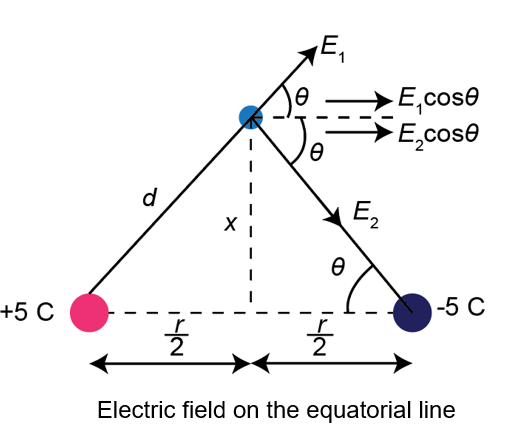The electric field on the equatorial line is represented as,

Here, \({E_1}\) is the electric field due to \( + 5{\rm{ C}}\), \({E_2}\) is the electric field due to \( - 5{\rm{ C}}\), and \(r\) is the separation between \( + 5{\rm{ C}}\) and \( - 5{\rm{ C}}\), \(x\) is the distance of the point from the equatorial line.
The distance of the point from the charge is,
\(d = \sqrt {{{\left( {\frac{r}{2}} \right)}^2} + {x^2}} \)
Substitute \(6{\rm{ m}}\) for \(r\), and \(4{\rm{ m}}\) for \(x\),
\(\begin{array}{c}d = \sqrt {{{\left( {\frac{{6{\rm{ m}}}}{2}} \right)}^2} + {{\left( {4{\rm{ m}}} \right)}^2}} \\ = 5{\rm{ m}}\end{array}\)
The electric field due to \( + 5{\rm{ C}}\) is,
\({E_1} = \frac{{K\left| {5{\rm{ C}}} \right|}}{{{d^2}}}\)
Here, \(K\) is the electrostatic force constant.
Substitute \(9 \times {10^9}{\rm{ N}} \cdot {{\rm{m}}^2}/{{\rm{C}}^2}\) for \(K\), and \({\rm{5 m}}\) for \(d\),
\(\begin{array}{c}{E_1} = \frac{{\left( {9 \times {{10}^9}{\rm{ N}} \cdot {{\rm{m}}^2}/{{\rm{C}}^2}} \right) \times \left| {5{\rm{ C}}} \right|}}{{{{\left( {5{\rm{ m}}} \right)}^2}}}\\ = 1.8 \times {10^9}{\rm{ N}}/{\rm{C}}\end{array}\)
The electric field due to \( - 5{\rm{ C}}\) is,
\({E_2} = \frac{{K\left| { - 5{\rm{ C}}} \right|}}{{{d^2}}}\)
Here, \(K\) is the electrostatic force constant.
Substitute \(9 \times {10^9}{\rm{ N}} \cdot {{\rm{m}}^2}/{{\rm{C}}^2}\) for \(K\), and \({\rm{5 m}}\) for \(d\),
\(\begin{array}{c}{E_2} = \frac{{\left( {9 \times {{10}^9}{\rm{ N}} \cdot {{\rm{m}}^2}/{{\rm{C}}^2}} \right) \times \left| { - 5{\rm{ C}}} \right|}}{{{{\left( {5{\rm{ m}}} \right)}^2}}}\\ = 1.8 \times {10^9}{\rm{ N}}/{\rm{C}}\end{array}\)
From geometry,
\(\cos \theta = \frac{{r/2}}{d}\)
Substitute \(6{\rm{ m}}\) for \(r\), and \(5{\rm{ m}}\) for \(d\),
\(\begin{array}{c}\cos \theta = \frac{{\left( {6{\rm{ m}}/2} \right)}}{{5{\rm{ m}}}}\\ = 0.6\end{array}\)
Due to symmetry of the system, the horizontal component of the field cancels each other. Therefore, the net electric field at the point on equatorial line is,
\(\begin{array}{c}E = {E_1}\cos \theta + {E_2}\cos \theta \\ = \left( {{E_1} + {E_2}} \right)\cos \theta \end{array}\)
Substitute \(1.8 \times {10^9}{\rm{ N}}/{\rm{C}}\) for \({E_1}\), \(1.8 \times {10^9}{\rm{ N}}/{\rm{C}}\) for \({E_2}\), and \(0.6\) for \(\cos \theta \),
\(\begin{array}{c}E = \left[ {\left( {1.8 \times {{10}^9}{\rm{ N}}/{\rm{C}}} \right) + \left( {1.8 \times {{10}^9}{\rm{ N}}/{\rm{C}}} \right)} \right] \times 0.6\\ = 2.16 \times {10^9}{\rm{ N}}/{\rm{C}}\end{array}\)
Hence, the electric field strength at a distance the \(4{\rm{ m}}\) on the equatorial line is \(2.16 \times {10^9}{\rm{ N}}/{\rm{C}}\).







